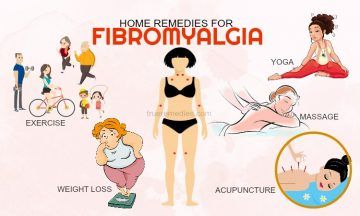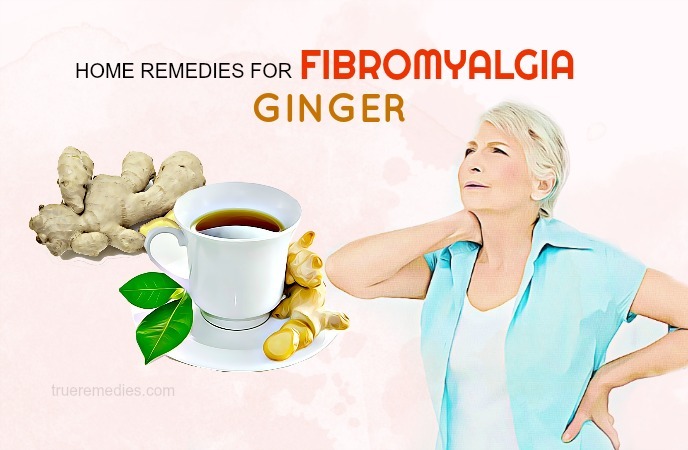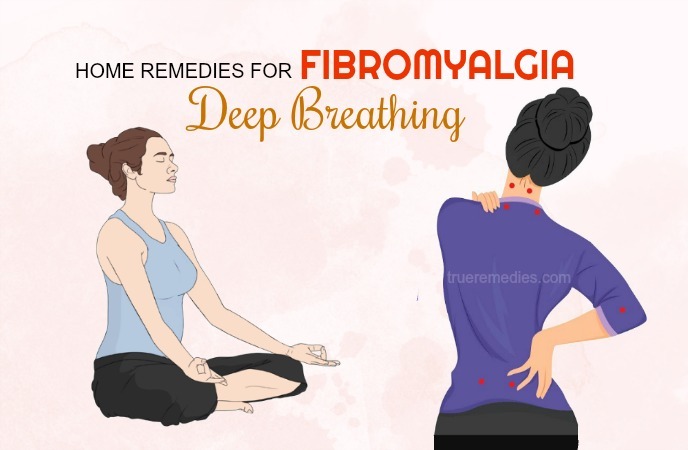updated: 06/24/2019
CONTENTS
Fibromyalgia is a syndrome affecting the soft tissues and muscles. This medical condition has some noticeable features such as chronic muscle pain, sleep issues, fatigue, painful tender points, and trigger points. They could be relieved by using medications, stress management, and lifestyle changes. So how to do it the right way? This article on TrueRemedies.com will show you how to get rid of fibromyalgia symptoms by applying home remedies for fibromyalgia pain relief. At first, you should acknowledge some basics about fibromyalgia, including what it is, what causes it, and what its symptoms are, what risk factors are, etc.
What Is Fibromyalgia?
It is a long-term and chronic disorder that is accompanied by widespread pain in the bones and muscles, fatigue, and tenderness of the affected areas. These are subjective symptoms, which means that they could not be measured or determined by tests. Moreover, its exact causes are unknown; so, fibromyalgia is usually misdiagnosed as another condition.
Because of the lack of objective, reproducible tests for this condition, some doctors may question the disorder altogether. Although it is much more widely accepted in the medical fields now than previously, some researchers and doctors do not consider fibromyalgia as an ailment. In accordance with the Mayo Clinic, this condition may enhance your potential risk of getting depression[1].
Many doctors now find that changes in lifestyle might be better than using the medication in both managing and treating this ailment.
What Are Symptoms Of Fibromyalgia?
Usually, fibromyalgia is usually accompanied by tenderness in the affected areas that are called tender points or trigger points. In such places on the body, even light pressure or reaction could lead to pain.
TrueRemedies Partner Solutions

Need a Help from the Leading Expert Online, Available 24/7?
They’re all here and ready to answer your questions online or by phone. Keep asking questions until you get the answer you need.
Nowadays, such points are not commonly used to diagnose fibromyalgia. Rather than, they might be used as a way for experts or doctors to reduce the number of possible diagnoses. Doctors can use both consistent symptoms and some medical tests to help them identify the causes.
The pain resulted from those trigger points could be described as a consistent dull ache impacting a lot of body parts. If you experience this pain for more than 3 months, then doctors might recognize this as a symptom of fibromyalgia.
People having this disorder also experience sleep problems, fatigue, headaches, sleeping too much without feeling rested, anxiety, depression, inability to pay attention or focus, troubles with memory, post-traumatic stress disorder, dull aching, or pain in the lower abdomen.
Symptoms of fibromyalgia might be a consequence of the nerves and brain misinterpreting or overreacting to regular pain signals. This might be because of a chemical imbalance within the human brain.
What Are Causes Of Fibromyalgia?
Medical researchers and doctors, in fact, do not know the real causes of this condition. But, over time, with the development of the medical field, they have recently figured out some factors contributing to this disease:
- Infections: Initial ailments might trigger fibromyalgia or make the symptoms of the issue worse.
- Genetics: Oftentimes fibromyalgia is based on heredity. If one of your family members has this condition, maybe you will develop it. Many researchers show that certain genetic mutations might play a specific role in this issue. Those genes have not been identified yet.
- Trauma: People experiencing physical and emotional trauma might suffer from fibromyalgia. This condition has been connected with post-traumatic stress disorder.
- Stress: Similar to trauma, stress could create long-reaching impacts on your body. It is linked to hormonal disturbances that may contribute to fibromyalgia.
What Are Trigger Points?
The person will be diagnosed with fibromyalgia if having widespread tenderness and pain in at least 1 out of the 18 known trigger points. Healthcare professionals will check how many points were painful by firmly pressing on them.
Some popular trigger points are:
- Upper chest
- The back of the head
- Upper chest
- Knees
- Hips
- Outer elbows
Normally, trigger points are not the focus of the diagnosing process for fibromyalgia. Rather than, if the symptoms of chronic widespread pain are felt for over 3 months without any diagnosable medical condition, you will be diagnosed with fibromyalgia.
What Are Risk Factors?
Although the causes of fibromyalgia are not clear, the flare-ups of this condition could be the consequence of physical trauma, psychological stress, or an unrelated systemic ailment like the flu. The nervous system and brain might misinterpret or overreact to usual pain signals. The incorrect interpretation might be because of an imbalance in the brain chemicals.
Besides, there are also other risk factors of fibromyalgia:
- Gender: Women are likely to prone to suffer from fibromyalgia than men.
- Family history: Heredity plays an important factor in the risk of developing fibromyalgia.
- Diseases: Although fibromyalgia is not a specific form of arthritis, suffering from a rheumatic diseases, including rheumatoid arthritis or lupus might increase your risk.
Top 22 Must-Try Home Remedies For Fibromyalgia Pain Relief
1. Exercise
If you are suffering from fibromyalgia, you should practice aerobic exercise and resistance training exercises or strength training exercises because it is linked to alleviation in tenderness, pain, stiffness, and sleep disturbance in a number of patients[2] [3] [4] [5].
If exercise may relieve the symptoms, it is crucial to maintain consistency to see progress. You may work out with a personal trainer or partner to keep it proactive.
2. Acupuncture
This therapy is one of the common effective remedies for fibromyalgia[6] [7] [8]. It is found that 1 in 5 people with fibromyalgia makes use of this therapy in 2 years of diagnosis, and they reported an improvement in stiffness and pain. Nonetheless, more studies still need to be done. The number of sessions recommended will depend on the severity and symptoms. But some experts claim that sham acupuncture might impact the pain and brain.
3. Yoga
According to a small study, women attending a 2-hour weekly yoga program and did the poses at home from 20 to 40 minutes per day experienced a reduction in 31% in symptoms, including fatigue and pain. The techniques of breathing might induce a relaxing response that alters signals of pain[9] [10] [11] [12].
4. Tai Chi
The study carried out by researchers at Tufts University claimed that gentle mind-body exercise could improve sleep and ease depression and pain related to fibromyalgia. The controlled breathing and movements of Tai Chi promoted a restful state, interrupting the pain cycle[13] [14] [15].
5. Massage
A 2010 study from Spain showed that participants having fibromyalgia underwent the 90-minute sessions of a form of massage named myofascial release for 20 times had noticed less anxiety and pain[16]. Fascia, which is the connective tissue surrounding organs and muscles, tightens in those with fibromyalgia, thereby increasing the pain. However, with gliding, slow pressure, massage may tight bands of fascia, thereby making them softer.
The massage therapy may relax your muscles and improve motions of your joints[17]. A kind of massage named manual lymph drainage therapy is beneficial for this condition. It may loosen up the lymph blockages which may be contributing to the pain.
In order to get the best results, you should have a massage therapist to do it.
6. Weight Loss
Decreasing your weight may alleviate your symptoms and might prevent you from suffering from fibromyalgia at the beginning. Although it is not clear why it could do that, the increased levels of inflammatory substances named cytokines, which is common in people with fibromyalgia and obese people, could trigger the pain and increase sensitivity to it. Increasing some extra weight might worsen symptoms. This may contribute to stress and fatigue on joints, increasing the pain[18]
7. Epsom Salt
Epsom salt (magnesium sulfate) is one of the effective remedies for fibromyalgia. Soaking in Epsom salt bath could help your own body take magnesium. Fibromyalgia is usually accompanied by the deficiency in magnesium. The soothing bath also decreases pain and induces relaxation[19].
Directions:
- Mix 2 cups of Epsom salt in a bathtub of warm water
- Soak in this solution for 20 minutes or more
- Repeat this routine thrice per week
8. Omega-3 Fatty Acids
Omega-3 fatty acids, unsaturated fats, may help in reducing neuropathic pain and inflammation. Also, they could curb the joint stiffness and pain[20] [21] [22].
- Consume 1-2 tablespoons of fish oil every day
- Alternatively, consume fatty fish such as sardines, herring, anchovies, wild salmon, or tuna for twice or thrice per week. Some other sources of omega-3 fatty acids are walnuts, flaxseeds, soybean oil, and canola oil.
- Choose fish oil or omega-3 supplements, but consult your healthcare provider in advance.
Note: People using blood-thinning medications should be careful when using omega-3 supplements because fish oil might interfere with it.
9. Apple Cider Vinegar
Apple cider vinegar may balance the pH levels of the human body, decrease oxidative stress, and boost blood circulation. This could reduce fibromyalgia symptoms, including gastrointestinal problems, headaches, fatigue, inflammation, swelling, and joint pain[23].
- Add 1-2 tablespoons of the raw, unfiltered apple cider vinegar into a glass of water
- Optionally, you can add some honey to taste
- Have it twice per day
In case you are not familiar with apple cider vinegar, add 1 teaspoon of a glass of water and steadily enhance the storage.
10. Turmeric
Because of its amazing anti-inflammatory properties, turmeric could deal with fibromyalgia associated with rheumatic disease[24] [25]. It has a compound named curcumin, which may help relieve stiffness and pain[26].
Method 1:
- Mix ½-1 teaspoon of turmeric powder into a cup of milk
- Then, boil it and let it cool down.
- Have it 1- 2 times per day
Method 2:
- Take this herb in the form of supplements for 400-600 mg thrice per day. Consult your doctor prior to using any supplement.
Or you could also add turmeric to your daily cooking routines.
11. Ginger
Ginger has pain-relieving and anti-inflammatory properties[27] that may decrease fibromyalgia symptoms[28] [29]. The antispasmodic properties of ginger help relieve muscle spasms and treat restless leg syndrome. If you have a fever, sipping one cup of ginger tea can help to reduce the fever. This is beneficial to fibromyalgia patients who have colds and sinus infections.
Method 1:
- Add 1 teaspoon of the freshly grated ginger to about 1 cup of boiling water
- Wait until it simmers for 10 minutes.
- After straining, have this tea for 3 times per day
Method 2:
Take ginger tablets with the proper dosage consulted by your doctor to get maximum results.
12. Cayenne Pepper
One of the powerful home remedies for fibromyalgia is cayenne pepper. It has capsaicin that acts as a natural pain reliever[30], and it is good for good blood circulation.
- Take the cayenne pepper capsules or extracts. For a suitable dosage, you should consult your doctor beforehand.
- Add cayenne pepper to your daily cooking.
- Besides, you can add a small quantity of capsaicin cream having 0.025% capsaicin
Note: Avoid applying cayenne pepper and capsaicin cream to inflamed or broken skin.
13. Camphor
Camphor is another good way to deal with fibromyalgia naturally[31]. It may tighten muscles, thereby decreasing pain[32]. A decrease in pain will boost the overall health of the human body as well. A lot of people suffering from backache had better try out this. They could either use it in the form of oil by applying camphor oil on the bones or muscles to help relieve the pain or eat camphor oil in the forms like coriander or anything else that is a member of the mint family.
14. Vegetables
Green vegetables are important because they offer necessary ingredients for the muscles and bones to remain well-maintained, thereby making them healthier and stronger. The consumption of veggies, such as pumpkin ought to be increased as well. A study found that a healthy vegetarian diet helps many fibromyalgia patients a lot[33]. Have as many green vegetables as you can. Make sure that you use lemon juice for boosting the taste.
In addition, you should avoid cabbage, potatoes, brinjal, spinach, and potatoes.
15. Liquid
The liquid is one of the simple home remedies for fibromyalgia because it helps to flush out toxins from your body and detoxify the system[34].
- Drink adequate quantities of water per day at least 2 liters a day
- Avoid diuretic or drinks with caffeine. Caffeine may reduce magnesium levels in the body. If you drink coffee, drink more water/fluid to keep hydrated and eliminate toxins
- Reduce alcohol
- Have a high alkaline diet. Alkaline-rich foods help reduce inflammation, relieve painful joints, and maintain hydration
16. Heat
This great remedy for relaxing muscles is also helpful for fibromyalgia, particularly for people who regularly have a cold[35] [36].
Many heating products are now available, such as:
- Heating pads
- Rice bags
- Hot water bottles
- Mattress pads or electric blankets
- Slippers or heated socks
17. Deep Breathing
In regard to home remedies for fibromyalgia, deep breathing may sound too simple, yet it may help alleviate the anxiety associated with this illness[37] [38].
Many people take shallow, short breaths, which could trigger the “fight-or-flight” response in the autonomic nervous system (ANS). When slowing down your breathing consciously, it may have opposite effects on the ANS, thereby letting your mind and body relax.
In addition to deep breathing, mindfulness meditation, which has been appreciated by many people and involves deep breathing and other practices, may help you a lot.
If you practice deep breathing for relieving symptoms of fibromyalgia, should not move upward. Rather than, you direct it lower your ribs and slowly breathe. Also, use this tip to calm your whole body when feeling stress and anxiety. Practice it at other times for a faster healing process as well.
18. Choose The Right Pillows And Beddings
It is important for fibromyalgia patients to use soft sheets. If you are suffering from this condition, find some clip-on sheet to keep it flat and taut. Also, they are called sheet suspenders or sheet garters.
In case you get morning pain due to fibromyalgia, you should switch to another type of pillow. Try other pillows with different thicknesses, or try out body pillows to see which ones are suitable for you[39].
19. Vitamin D
People with fibromyalgia often have deficiencies of both magnesium and vitamin D levels. However, there is not any evidence that taking supplements of these vitamins are an efficient fibromyalgia remedy. Vitamin D has some effects on muscle and nerve function. Studies have shown that low level of vitamin D might be associated with chronic pain – one of the symptoms of fibromyalgia[40] [41].
20. Capsaicin Application
Capsaicin is originated from pepper plants and is reckoned as an effective, natural pain reliever. Being an active ingredient in many OTC lotions and sprays, capsaicin, when being applied on the painful body area, may stimulate the production of a chemical named substance P. Because this substance is depleted, the sensation of pain may reduce. Usually, capsaicin has been used for chronic pain in cancer, diabetes, and cluster headaches. Also, it might relieve fibromyalgia pain temporarily[42] [43] [44].
21. Biofeedback
This alternative therapy for fibromyalgia uses the connection between mind and body to help you control your pain by using mind power. The feedback might come in different forms, be it muscle tension, brain wave measurements, or skin temperature.
Biofeedback is beneficial for a number of the painful condition if used accompanied by other therapies. Some studies noted the effectiveness of this method[45] [46] [47] [48].
22. Meditation
Last but not least effective in regard to home remedies for fibromyalgia is meditation[49] [50] [51] [52]. Sometimes, just simply taking away from the hustle and bustle of city life could ease severe fibromyalgia symptoms naturally. Meditation has been shown to help some individuals having fibromyalgia deal with the side effects of anxiety, stress, and depression. Especially, according to an 8-week study conducted by researchers in the University of Basel, a meditative technique called Mindfulness-Based Stress Reduction (MBSR) gave promising results from some fibro sufferers who used it at home to decrease stress as well as pain associated with fibro. With MBSR, you just need to find a quiet place to lay down without being disturbed by anything else for a while. Close the eyes, concentrate on your breathing patterns till it slows down into a meditative state. After that, feel where the stress and pain are situated within your body and use the visualization to imagine that pain is flowing out from your body. MBSR might take some efforts to do it right, but it is very worth a try as a natural option among remedies for fibromyalgia.
Additional Tips
Aside from applying some of 24 home remedies for fibromyalgia mentioned above, there are some steps you should take to get faster healing and prevent it from coming back:
- Build a regular sleep routine and get adequate sleep
- Plan a balanced, healthy diet
- Try out an elimination diet in order to test for any possible food sensitivities so that you could eradicate potential food allergens from your own diet.
- Avoid caffeine because it might disrupt your sleep pattern and worsen symptoms of restlessness and anxiety.
- Take a magnesium supplement every day. Consult your doctor in advance.
- Take some supplements such as 5-HTP (50mg, for 1-3 times per day), L-carnitine (500mg, for 2 times per day), and SAM-e (about 400mg, for 2 times per day). Always have consultations of your doctor first.
It is not necessary for you to dance in the moonlight at midnight in order to get relief with the use of these natural remedies for fibromyalgia. These 22 methods might give you added relief aside from the treatments that your regular doctor have given you. Make sure that you control your feelings and results from these remedies so that you could report them to your healthcare provider and decide if you want to keep doing it or not. Hopefully, some of these home remedies for fibromyalgia will help you get better so you can live the way you want. For any contributing ideas about this post, feel free to drop your words at the comment box below. To have more similar beauty and health tips, do not hesitate to visit our main Home Remedies page.













